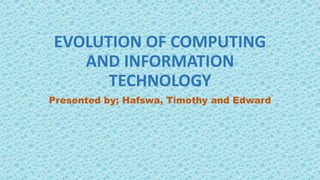
evolution research.pptx
- 1. EVOLUTION OF COMPUTING AND INFORMATION TECHNOLOGY Presented by; Hafswa, Timothy and Edward
- 2. TERMS AND THEIR DEFINITIONS; Evolution in computers; • Refers to the change in computer technology right from the time computers were first used to the present. Computing; • The use or operation of computers. Information and Technology; • The study or use of systems (especially computers and telecommunication) for storing, retrieving and sending information.
- 3. BRIEF HISTORY OF COMPUTING Computing began at a mechanical level, to information level (software), to human level and finally community level. Each level of a system evolution is built on the previous one. Earlier in 3000 BC, the Chinese abacus was invented making it the first mechanical computing device. It was used for adding and counting. It is in the position of beads that this computer represents and stores data. However, its only a data storage system so it must be combined with a human to create a complete computational machine. With time, more sophisticated computing machines were invented for example gears by Blaise Pascal of France, Babbage established machines that would print results of computation on paper in order to eliminate possibility of errors. There is progression of flexibility in these machines from one generation to another.
- 4. COMPUTER GENERATIONS oGeneration in computer terminology is a change in technology a computer is/ was being used. oInitially the generation term was used to distinguish between varying hardware technologies. oBut nowadays, computer includes both hardware and software ,which together make up an entire computer system. oThere are totally five computer generations known till date.
- 6. FIRST GENERATION(1942-1955) Early computers were manufactured using vacuum tubes as the electronic switching device. The vacuum tubes worked on the principle of storing program instructions along with data in memory of computer so they could automatically execute a program without human intervention. Instructions were written in machine and assembly language. These computers were the fastest of their time, they were bulky and large in size requiring large rooms for instillation , used many vacuum tubes that emitted large amount of heat and consumed a lot of power. Since vacuum tubes used filaments which had limited life’ therefore they were very expensive and could only be afforded by very large organizations.
- 7. SECOND GENERATION(1955-1964) In this generation transistors which are electronic switches that alternately allow electronic signals to pass through them were used since they were cheaper, consumed less power, more compact in size, more reliable, faster than first generation machines made of vacuum tubes and generally easier to handle since they were made of germanium conductor not glass. Their memory was composed of magnetic cores but later researchers introduced magnetic tapes as faster and more convenient secondary storage medium with time , magnetic disk storage was developed. High level programming language was used during this error.
- 8. THIRD GENERATION (1964-1970) This period was marked by the use of Integrated Circuits (IC’s) in place of transistors. They are electronic circuits that package transistors and other electronic components into one small silicon chip called semiconductor. The invention of IC’s made computers smaller in size, reliable, cheaper and efficient. In this generation, keyboards and monitors were used and magnetic disks were used widely as secondary storage.
- 9. FOURTH GENERATION (1971-1980) Computers used Very Large Scale Integrated(VLSI) circuits and Large Scale Integrated(LSI) circuits. VLSI circuits had about 5000 transistors and other circuit elements with their associated circuits on a single chip and this made it possible to have microcomputers like the personal computer(PC) in this generation. VLSI circuits were also known as the microprocessors and Intel was the first company to develop a microprocessor. Computers made in this generation were more powerful, small in size, reliable and affordable.
- 10. FIRTH GENERATION(1980- Till date) In this generation VLSI technology evolved into ULSI ( Ultra Large Scales Integrated) technology resulting in the fabrication of microprocessor chips with 10 million electronic components. Computers use AI (artificial intelligence) technology which includes; Development of expert systems, Game playing, robotics, natural language understanding and neural networks. Examples of the fifth generation computers are IBM SP/2 notebooks, Pentium PCs, SUN workstations, IBM SP/2 desktops and PARAM supercomputers.
- 11. CONCLUSION; Researching, studying and writing on the ‘History of Computing and Information Technology’ has indeed been a fulfilling, but challenging task and has brought about greater appreciation of several work done by scientists of old, great developmental research carried out by more recent scientists and of course the impact of all innovations has made on the development of the human race. It has created greater awareness of the need to study the history of computing as the means of knowing how to improve on the existing computer technology. Finally, it is hoped that this document is found suitable as a good summary of ‘ The History of Computing and Information Technology’ and challenging to upcoming scientists and engineers to study the history of their profession.
- 12. GUIDING QUESTIONS; 1. List key hardware technologies used in building computers of each of the five generations. 2. List key software technologies used in building computers of each of the five generations. 3. What are the advantages of transistors over vacuum tubes? 4. What is an IC and how does it help in reducing the size of computers? 5. Name the technologies used for constructing main memory in first, second, third and fourth generation computers. 6. Name the secondary storage media popularly used in first, second, third, fourth and fifth generation computers.